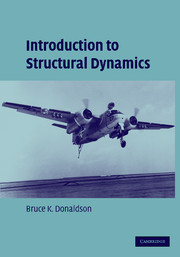Book contents
- Frontmatter
- Contents
- Preface for the Student
- Preface for the Instructor
- Acknowledgments
- List of Symbols
- 1 The Lagrange Equations of Motion
- 2 Mechanical Vibrations: Practice Using the Lagrange Equations
- 3 Review of the Basics of the Finite Element Method for Simple Elements
- 4 FEM Equations of Motion for Elastic Systems
- 5 Damped Structural Systems
- 6 Natural Frequencies and Mode Shapes
- 7 The Modal Transformation
- 8 Continuous Dynamic Models
- 9 Numerical Integration of the Equations of Motion
- Appendix I Answers to Exercises
- Appendix II Fourier Transform Pairs
- Index
Preface for the Student
Published online by Cambridge University Press: 30 November 2009
- Frontmatter
- Contents
- Preface for the Student
- Preface for the Instructor
- Acknowledgments
- List of Symbols
- 1 The Lagrange Equations of Motion
- 2 Mechanical Vibrations: Practice Using the Lagrange Equations
- 3 Review of the Basics of the Finite Element Method for Simple Elements
- 4 FEM Equations of Motion for Elastic Systems
- 5 Damped Structural Systems
- 6 Natural Frequencies and Mode Shapes
- 7 The Modal Transformation
- 8 Continuous Dynamic Models
- 9 Numerical Integration of the Equations of Motion
- Appendix I Answers to Exercises
- Appendix II Fourier Transform Pairs
- Index
Summary
No actual structure is rigid. All structures deform under the action of applied loads. When the applied loads vary over time, so, too, do the deflections. The time-varying deflections impart accelerations to the structure. These accelerations result in body forces called inertial loads. Since these inertia loads affect the deflections, there is a feedback loop tying together the deflections and at least the inertial load part of the total loads. When the applied loads result from the action of a surrounding liquid, then the deflections determine all the applied dynamic loads. Therefore, unlike static loads (i.e., slowly applied loads), differential equations based on Newton's laws are required to mathematically describe time-varying load–deflection interactions. Inertial loads can also have the importance of being the largest load set acting on parts of a structure, particularly if the structure is quite flexible.
In order to appreciate how significant time-varying forces can be, consider, for example, the time-varying loads that act on a typical large aircraft. After the aircraft starts its engines, it generally must taxi along taxiways to a runway and then travel along the runway during its takeoff run. Taxiways and runways are not perfectly flat. They have small alternating hills and valleys. As will be examined in a simplified form later in this book, these undulations cause the aircraft to move up and down and rock back and forth on its landing gear, that is, its suspension system.
- Type
- Chapter
- Information
- Introduction to Structural Dynamics , pp. xi - xivPublisher: Cambridge University PressPrint publication year: 2006

